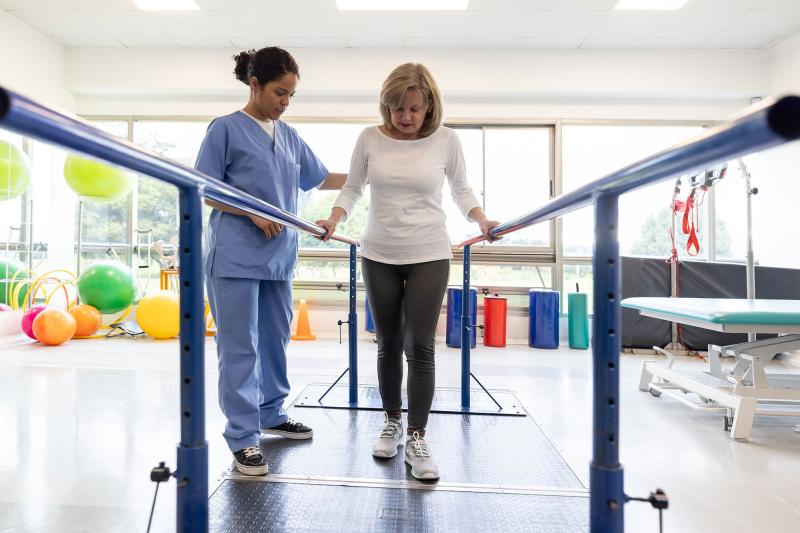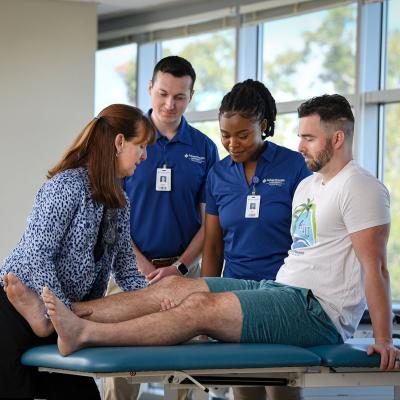- AdventHealth University

If you’re drawn to helping others regain independence and improve their quality of life, occupational or physical therapy may be right for you. While both fields aim to enhance patient well-being, they approach it differently. Understanding the difference between OT and PT is important for making an informed decision about your career.
What’s the Difference Between Occupational Therapy and Physical Therapy?
Physical and occupational therapy focus on different aspects of a patient’s life. Physical therapists (PTs) primarily address movement and mobility. They work with patients to improve their strength, flexibility and range of motion, often after an injury, surgery or illness.
On the other hand, occupational therapists (OTs) concentrate on helping patients perform daily activities that are meaningful to them. This can include anything from dressing and bathing to cooking and working.
OT vs. PT: Understanding Their Objectives
Although occupational and physical therapy seem similar, the benefits they bring to patients are different. Let’s take a closer look at their objectives.
Physical therapy (PT):
- Aims to improve gross motor skills and overall physical function: This could involve helping a stroke patient regain the ability to walk or assisting an athlete in returning to a sport after an ACL tear.
- Focuses on restoring movement, function and reducing pain: For a patient recovering from a knee replacement, a PT would design exercises to strengthen the quadriceps and hamstrings, improve balance and reduce swelling.
- Helps patients recover from injuries, manage chronic conditions and prevent future problems: PTs work with patients with arthritis, Parkinson’s disease and spinal cord injuries, providing personalized treatment plans to enhance their quality of life.
- Utilizes exercises, manual therapy and modalities like ultrasound and electrical stimulation: For a patient with chronic back pain, a PT might use manual therapy to mobilize the spine, ultrasound to reduce inflammation and prescribe specific exercises to improve core strength.
Occupational therapy (OT):
- Adapts environments and tasks to promote independence: This could involve modifying a home environment with grab bars and raised toilet seats or teaching a patient with cognitive impairments how to use a memory aid to manage their medications.
- Addresses physical, cognitive and psychosocial factors that impact a patient’s ability to function: An OT working with a child with autism might address sensory processing issues that interfere with their ability to focus in school or participate in social activities.
- Focuses on enhancing the ability to perform activities of daily living (ADLs): An OT might work with a patient who has difficulty dressing due to arthritis, teaching them adaptive techniques and recommending assistive devices like button hooks or zipper pulls.
- Helps patients with disabilities, developmental delays or cognitive impairments: OTs work with individuals of all ages, from infants with developmental delays to older adults with dementia, helping them to live more fulfilling lives.
There are different types of physical therapy and occupational therapy, leading to diverse career opportunities. You can work in hospitals, rehabilitation centers, schools, home health agencies and private practices.
What Are the Daily Responsibilities of OT and PT?
When considering a career as an occupational or physical therapist, it’s good to understand the day-to-day responsibilities of the work you’ll be performing.
Physical Therapists:
- Conduct thorough assessments of patients’ movements and function: This might involve goniometric measurements of joint range of motion, manual muscle testing and gait analysis.
- Develop and implement personalized treatment plans: For a patient with a rotator cuff tear, a PT would create a plan that includes strengthening exercises, stretching and pain management techniques.
- Educate patients on exercises and strategies for self-management: This could involve teaching a patient how to perform a home exercise program or providing education on proper body mechanics.
- Monitor progress and adjust treatment as needed: PTs regularly reassess patients’ progress and modify their treatment plans to ensure optimal outcomes.
Occupational Therapists:
- Evaluate patients’ abilities to perform daily tasks: This might involve observing a patient’s ability to prepare a meal, clean their house or use public transportation.
- Collaborate with patients, families and other health care professionals: OTs work closely with physicians, nurses, social workers and other health care team members to provide integrative care.
- Create personalized intervention plans to address specific needs: For a patient with a spinal cord injury, an OT would develop a plan that addresses their specific needs, such as wheelchair mobility, transfers and self-care.
- Provide adaptive equipment and teach compensatory strategies: OTs might recommend and train patients to use adaptive equipment, like reachers, long-handed sponges or universal cuffs. They also teach compensatory strategies, like energy conservation.
Understanding the daily tasks of each profession is a great first step in determining which career to pursue.
PT vs. OT: Education and Licensure
Occupational and physical therapy require advanced education and rigorous licensure to ensure practitioners are qualified to provide safe and effective patient care.
Physical Therapy
To become a physical therapist, you must earn a Doctor of Physical Therapy (DPT) degree, which typically takes three years to complete. Licensure is required in all U.S. states. To obtain a license, graduates must pass the National Therapy Examination (NPTE), administered by the Federation of State Boards of Physical Therapy (FSBPT). Continuing education is typically required to maintain licensure.
Occupational Therapy
Occupational therapists must earn a Master of Occupational Therapy (MOT) or a Doctor of Occupational Therapy (DOT) degree. Licensure is also required in all U.S. states. Graduates must pass the National Board for Certification in Occupational Therapy (NBCOT) examination to become certified as a registered occupational therapist. Like PTs, OTs must also complete continuing education to maintain their licensure, with requirements varying by state.
Advance Your Career With AdventHealth University
At AdventHealth University, we’re committed to providing a faith-affirming and purpose-filled environment for students to gain the knowledge and skills needed to succeed in health care. Our programs in occupational therapy and physical therapy are designed to prepare you for a fulfilling career helping others. If you’re interested in either of these careers, contact us and a member of our team can help you begin your education.


